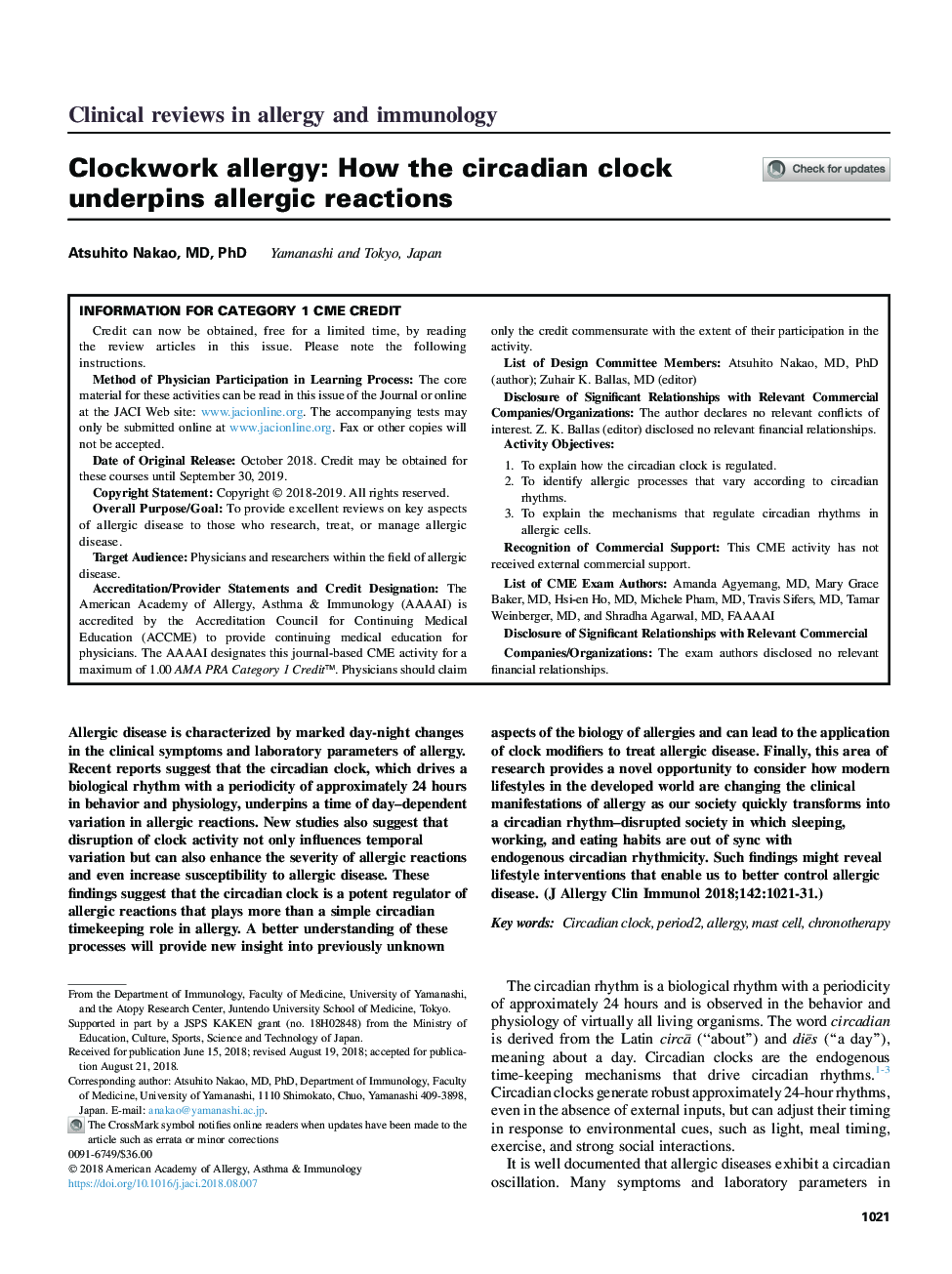| کد مقاله | کد نشریه | سال انتشار | مقاله انگلیسی | نسخه تمام متن |
|---|---|---|---|---|
| 11014597 | 1792927 | 2018 | 11 صفحه PDF | دانلود رایگان |
عنوان انگلیسی مقاله ISI
Clockwork allergy: How the circadian clock underpins allergic reactions
ترجمه فارسی عنوان
آلرژی آلت تناسلی: چگونه ساعت های شبانه روزی واکنش های آلرژیک را تحت تأثیر قرار می دهند
دانلود مقاله + سفارش ترجمه
دانلود مقاله ISI انگلیسی
رایگان برای ایرانیان
کلمات کلیدی
Aquaporin 3clock-controlled geneCryptochromeAQP3TEWLCCGSCNBmal1 - BMAL1PCA - PCAAllergy - آلِرژیPassive cutaneous anaphylaxis - آنافیلاکسی پوستی منفعلTransepidermal water loss - از دست دادن آب دریچهper - در هرAtopic dermatitis - درماتیت آتوپیکPeriod2 - دوره 2Period - دوره زمانیClock - ساعتCircadian Clock - ساعت دیجیتالMast cell - ماستسلSuprachiasmatic nucleus - هستههای سوپراکیاسماتیکcasein kinase - کازئین کینازChronotherapy - کرونوتراپیCry - گریه کردن
موضوعات مرتبط
علوم زیستی و بیوفناوری
ایمنی شناسی و میکروب شناسی
ایمونولوژی
چکیده انگلیسی
Information for Category 1 CME CreditCredit can now be obtained, free for a limited time, by reading the review articles in this issue. Please note the following instructions.Method of Physician Participation in Learning Process: The core material for these activities can be read in this issue of the Journal or online at the JACI Web site: www.jacionline.org. The accompanying tests may only be submitted online at www.jacionline.org. Fax or other copies will not be accepted.Date of Original Release: October 2018. Credit may be obtained for these courses until September 30, 2019.Copyright Statement: Copyright © 2018-2019. All rights reserved.Overall Purpose/Goal: To provide excellent reviews on key aspects of allergic disease to those who research, treat, or manage allergic disease.Target Audience: Physicians and researchers within the field of allergic disease.Accreditation/Provider Statements and Credit Designation: The American Academy of Allergy, Asthma & Immunology (AAAAI) is accredited by the Accreditation Council for Continuing Medical Education (ACCME) to provide continuing medical education for physicians. The AAAAI designates this journal-based CME activity for a maximum of 1.00 AMA PRA Category 1 Creditâ¢. Physicians should claim only the credit commensurate with the extent of their participation in the activity.List of Design Committee Members: Atsuhito Nakao, MD, PhD (author); Zuhair K. Ballas, MD (editor)Disclosure of Significant Relationships with Relevant Commercial Companies/Organizations: The author declares no relevant conflicts of interest. Z. K. Ballas (editor) disclosed no relevant financial relationships.Activity Objectives:1.To explain how the circadian clock is regulated.2.To identify allergic processes that vary according to circadian rhythms.3.To explain the mechanisms that regulate circadian rhythms in allergic cells.Recognition of Commercial Support: This CME activity has not received external commercial support.List of CME Exam Authors: Amanda Agyemang, MD, Mary Grace Baker, MD, Hsi-en Ho, MD, Michele Pham, MD, Travis Sifers, MD, Tamar Weinberger, MD, and Shradha Agarwal, MD, FAAAAIDisclosure of Significant Relationships with Relevant CommercialCompanies/Organizations: The exam authors disclosed no relevant financial relationships.Allergic disease is characterized by marked day-night changes in the clinical symptoms and laboratory parameters of allergy. Recent reports suggest that the circadian clock, which drives a biological rhythm with a periodicity of approximately 24 hours in behavior and physiology, underpins a time of day-dependent variation in allergic reactions. New studies also suggest that disruption of clock activity not only influences temporal variation but can also enhance the severity of allergic reactions and even increase susceptibility to allergic disease. These findings suggest that the circadian clock is a potent regulator of allergic reactions that plays more than a simple circadian timekeeping role in allergy. A better understanding of these processes will provide new insight into previously unknown aspects of the biology of allergies and can lead to the application of clock modifiers to treat allergic disease. Finally, this area of research provides a novel opportunity to consider how modern lifestyles in the developed world are changing the clinical manifestations of allergy as our society quickly transforms into a circadian rhythm-disrupted society in which sleeping, working, and eating habits are out of sync with endogenous circadian rhythmicity. Such findings might reveal lifestyle interventions that enable us to better control allergic disease.
ناشر
Database: Elsevier - ScienceDirect (ساینس دایرکت)
Journal: Journal of Allergy and Clinical Immunology - Volume 142, Issue 4, October 2018, Pages 1021-1031
Journal: Journal of Allergy and Clinical Immunology - Volume 142, Issue 4, October 2018, Pages 1021-1031
نویسندگان
Atsuhito MD, PhD,
